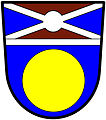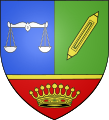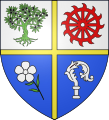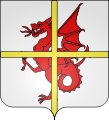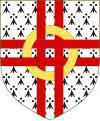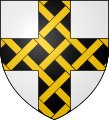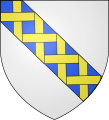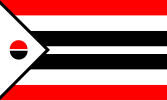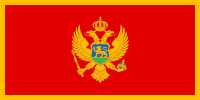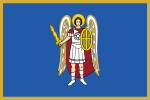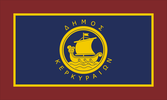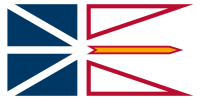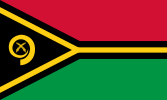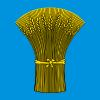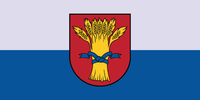
A saltire, also called Saint Andrew's Cross or the crux decussata, is a heraldic symbol in the form of a diagonal cross. The word comes from the Middle French sautoir, Medieval Latin saltatoria ("stirrup").

In heraldry, variations of the field are any of a number of ways that a field may be covered with a pattern, rather than a flat tincture or a simple division of the field.
Ordinaries in heraldry are sometimes embellished with stripes of colour alongside them, have lumps added to them, shown with their edges arciform instead of straight, have their peaks and tops chopped off, pushed up and down out of the usual positions, or even broken apart.

In heraldry, an ordinary is one of the two main types of charges, beside the mobile charges. An ordinary is a simple geometrical figure, bounded by straight lines and running from side to side or top to bottom of the shield. There are also some geometric charges known as subordinaries, which have been given lesser status by some heraldic writers, though most have been in use as long as the traditional ordinaries. Diminutives of ordinaries and some subordinaries are charges of the same shape, though thinner. Most of the ordinaries are theoretically said to occupy one-third of the shield; but this is rarely observed in practice, except when the ordinary is the only charge.
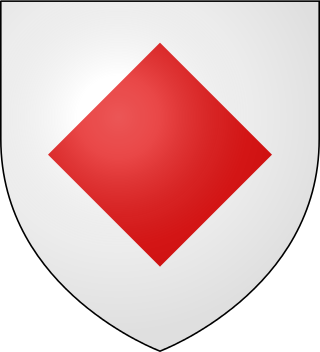
The lozenge in heraldry is a diamond-shaped rhombus charge, usually somewhat narrower than it is tall. It is to be distinguished in modern heraldry from the fusil, which is like the lozenge but narrower, though the distinction has not always been as fine and is not always observed even today. A mascle is a voided lozenge—that is, a lozenge with a lozenge-shaped hole in the middle—and the rarer rustre is a lozenge containing a circular hole in the centre. A lozenge throughout has "four corners touching the border of the escutcheon". A field covered in a pattern of lozenges is described as lozengy; similar fields of mascles are masculy, and fusils, fusily. In civic heraldry, a lozenge sable is often used in coal-mining communities to represent a lump of coal.

In heraldry and vexillology, fimbriation is the placement of small stripes of contrasting colour around common charges or ordinaries, usually in order for them to stand out from the background, but often simply due to the designer's subjective aesthetic preferences, or for a more technical reason to avoid what would otherwise be a violation of the rule of tincture. While fimbriation almost invariably applies to both or all sides of a charge, there are very unusual examples of fimbriation on one side only. Another rather rare form is double fimbriation, where the charge or ordinary is accompanied by two stripes of colour instead of only one. In cases of double fimbriation the outer colour is blazoned first. The municipal flag of Mozirje, in Slovenia, show an example of fimbriation that itself is fimbriated.

A roll of arms is a collection of coats of arms, usually consisting of rows of painted pictures of shields, each shield accompanied by the name of the person bearing the arms.

In heraldic blazon, a chief is a charge on a coat of arms that takes the form of a band running horizontally across the top edge of the shield. Writers disagree in how much of the shield's surface is to be covered by the chief, ranging from one-fourth to one-third. The former is more likely if the chief is uncharged, that is, if it does not have other objects placed on it. If charged, the chief is typically wider to allow room for the objects drawn there.
In heraldry, an avellane cross is a form of cross which resembles four hazel filberts in their husks or cases, joined together at the great end. The term comes from the Latin name for the hazel, originally Nux avellana. It was fairly rare in English heraldry.

In heraldry and heraldic vexillology, a blazon is a formal description of a coat of arms, flag or similar emblem, from which the reader can reconstruct the appropriate image. The verb to blazon means to create such a description. The visual depiction of a coat of arms or flag has traditionally had considerable latitude in design, but a verbal blazon specifies the essentially distinctive elements. A coat of arms or flag is therefore primarily defined not by a picture but rather by the wording of its blazon. Blazon is also the specialized language in which a blazon is written, and, as a verb, the act of writing such a description. Blazonry is the art, craft or practice of creating a blazon. The language employed in blazonry has its own vocabulary, grammar and syntax, which becomes essential for comprehension when blazoning a complex coat of arms.

In heraldry, the term attitude describes the position in which a figure is emblazoned as a charge, a supporter, or as a crest. The attitude of a heraldic figure always precedes any reference to the tincture of the figure and its parts. Some attitudes apply only to predatory beasts, exemplified by the beast most usual to heraldry – the heraldic lion; other terms apply to docile animals, such as the doe, usually emblazoned as a "hind".

In heraldry, a bar is an ordinary consisting of a horizontal band across the shield. If only one bar appears across the middle of the shield, it is termed a fess; if two or more appear, they can only be called bars. Calling the bar a diminutive of the fess is inaccurate, however, because two bars may each be no smaller than a fess. Like the fess, bars too may bear complex lines. The diminutive form of the bar is the barrulet, though these frequently appear in pairs, the pair termed a "bar gemel" rather than "two barrulets".
In heraldry, a mount is a representation of a hill or mountain as a curved terrace in base. When the mount is included in the lower part of the shield, it may be considered an ordinary rather than a charge.

Belgian heraldry is the form of coats of arms and other heraldic bearings and insignia used in the Kingdom of Belgium and the Belgian colonial empire but also in the historical territories that make up modern-day Belgium. Today, coats of arms in Belgium are regulated and granted by different bodies depending on the nature, status, and location of the armiger.

The Order of the Golden Stole or Stola d'Oro was an adjunct order of the Order of Saint Mark, in the Republic of Venice. It had a single class, that of knight. Its members were those members of the Order of Saint Mark who were of patrician rank, and wore a golden, flower-embroidered mantle as a token of this.
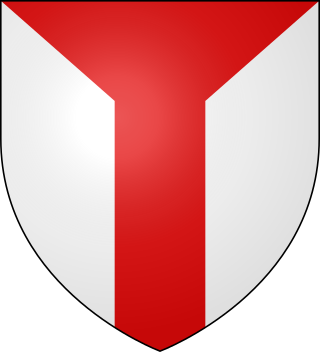
The gusset is a heraldic charge resembling the union of a pile with a pale extending from chief to base. In French heraldry, it has been classed as one of the thirty honorable ordinaries. For an 'inverted' gusset, one issuing from base and extending to the chief, some authors prefer the term graft.
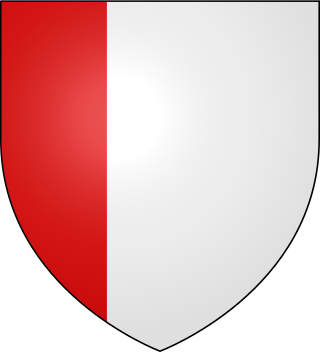
The side, or flank, is a heraldic ordinary resembling a pale that has been displaced to either the dexter or sinister edge of the field. Pierre-Barthélemy Gheusi, following M. Aug. Tailhades, groups the sides with the chief and base as ordinaries that are affixed to an edge of the field by their longest side.
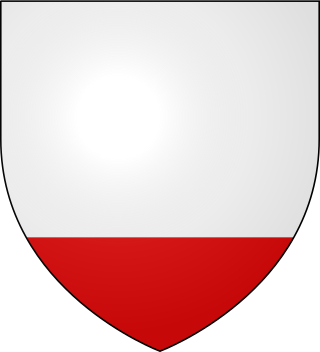
The base, more formally the terrace in base or champagne, is a heraldic charge that occupies the lower third of the field. It is in that sense the inverse correlate of the chief. In French heraldry, the champagne is considered an ‘honourable ordinary’, but in English heraldry it is frequently omitted from lists of the ‘honourable ordinaries’, and grouped, if at all, with the subordinaries. The diminutive of the base, occupying one half the height of the ordinary, is termed ‘plaine’ in French heraldry. Another, now less common, English language term for the base is the ‘Foot’, a usage the recalls the Germanic Schildfuß, Danish skjoldfod, or Dutch schildvoet.
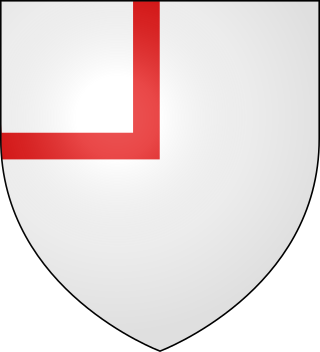
Esquarre is a name for both a heraldic ordinary and a set of related mobile charges. As an ordinary, the Esquarre is defined as a charge that borders a quarter on its two interior edges abutting the field. The Esquarre isolates the quarter from the rest of the field. De Galway suggested that the Esquarre is employed when both quarter and field are the same tincture. The shape of the ordinary is likened to a carpenter's square, a tool formed of two arms joined perpendicularly. When the two arms are of unequal length, the term potence (Fr.) is also used, a term likening the form of this variant to a joined post and crossbeam, or gallows/scaffold.
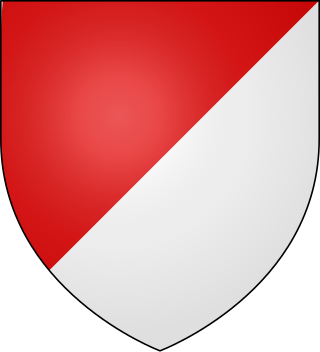
The Esquire is a heraldic charge that is classed as a subordinary in Anglophone heraldry. Its form is defined as resembling the Gyron, as formed of a right triangle; but, with the difference that whereas the Gyron extends from the outer edge of the field to the center, the Esquire extends across the whole of the field, from one edge to its opposite.



